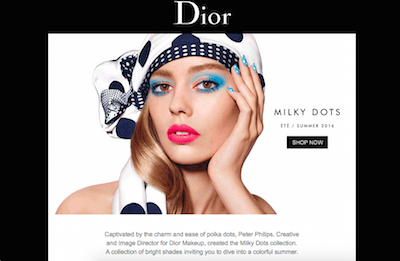British fashion label Burberry and French jeweler Cartier are the top email marketers, according to a new report from ContactLab and Exane BNP Paribas.
“The Dawn of Luxury CRM: Email do’s and don’ts” examines brand’s practices for engaging their clientele through email and searches for better solution. Email is an extremely common marketing practice that is not being expanded via technology, but the result is that many brands are lagging behind on best practices.
“Seventy-five percent of ecommerce clients, and 25 percent of in-store clients subscribe to newsletters,” said Marco Pozzi, senior advisor of ContactLab, Milan, Italy. “Email subscribers spend in general 20-25 percent more on a yearly basis.
“Mobile responsive mail are vital for mobile marketing and commerce, although only nine brands embrace this technology,” he said. “Emails are also important for fostering cross-channel integration: 20 brands have emails with a link to a store locator; strangely only Burberry has email with a collect-in-store feature and only Cartier has a link to book an appointment.”
Room to improve
The study revealed that the majority of luxury brands have not fully capitalized on the potential of effective email marketing. Evaluated in email proficiency and strategy, average scores were 34/92 and 28/71, respectively.
Cartier and Burberry were the two top performers overall. Cartier had the highest score in email strategy, at 36, and a proficiency score of 49, while Burberry led the pack with a 51 proficiency score and was tied for second with Dior in strategy at 32.

Zegna email
Fendi, Armani and Ferragamo also performed well, exceeding the average in both categories, with Tod’s, Louis Vuitton, Tiffany and Gucci on their heels. Michael Kors was second in proficiency overall, with Ralph Lauren, Zegna, Hugo Boss and Balenciaga joining it as brands above average in proficiency but below average in strategy.
On the other side, Dior rated highly in strategy, along with Hermès, Valentino, and Chanel, with Dior also approaching average in proficiency. Saint Laurent, Bottega Veneta, Dolce & Gabbana and Bulgari trailed further behind in strategy. Givenchy, meanwhile, had the lowest score in both strategies.
ContactLab and Exane found that email was localized and properly structured, offering a good mix of visuals and copy, effectively worded prompts and information and a range of languages. On the other hand, emails are poorly integrated into ecommerce and cross-channel services, and contact plans are insufficiently segmented.

Dior email
The failure to integrate email marketing into the broader digital marketing strategy means that digital engagement in general is down. Boosting digital engagement can translate into 40 percent more revenue, so a fully integrated strategy including email could lead to big gains.
Consumer expectations of email have evolved, but not all brands should follow suit. Tailored, specific emails are expected, but even having the proper title and recognizing gender is a struggle for some brands.
More specifically, very few brands ask for ZIP codes, which would allow brands to segment consumers geographically and allow more specific and personal recommendations and offers. Likewise, few brands ask for a consumer’s preferred product category.

Jimmy Choo St Tropez promotional email
As more sophisticated omnichannel and mobile strategies, such as customer recognition in-store with iBeacons and more elaborate social media campaigns, the relative oldness of emailing as a form of marketing has caused brands to stagnate. However, email’s role in the lives of consumers is not decreasing, so brands must ensure that email communications are optimal even as newer, trendier and youth-skewing marketing platforms enter the public consciousness.
Getting personal
The effectiveness of personalizing email has been verified by other reports.
While it may seem like a simple addition to branded communications, two-thirds of retailers do not use consumer data to personalize email offers, according to a recent report by Yesmail.
Yesmail’s “The 2016 Yesmail Marketing Channel Report” also found that more than one-third of retailers do not personalize subject lines and the majority do not insert the intended recipient’s name in the email body and more so, 64 percent do not personalize any email copy. With so much buzz centered on the omnichannel concept, retailers are missing a mark that can easily be solved through the integration of consumer data mined for existing digital channels (see story).
Similarly, additional reports have proven the ineffectiveness of email marketing from the consumer standpoint.
Email marketing is a cost-effective way to communicate with customers, but retailers may need to rethink their messaging strategy to get the most out of their campaigns, according to a study by First Insight.
While a small percentage of consumers cannot get enough emails from brands, most complain about the frequency of messages from brands, which can make a subscriber feel they are being spammed. With fewer yet personalized emails, brands can get a better return on their effort, as consumers are more likely to open and convert when the message is aimed at their interests (see story).
"[Brands need to have] the right content balance between brand building and commercial drive,” Mr. Pozzi said. “Today we see too much focus on commercial content; Hermès is the best practice correctly mixing branding/commerce and driving to store content.
"Also, personalization (name/title/subject), customization of content (by gender, purchasing history, geographical residence,” he said.
“From the analysis it stands out that the contact frequency is too high, especially for U.S. brands. From our experience, if the content is well received and varied, the correct contact frequency in the U.S. is from 1 to 2 email per week. Burberry is 1.6; Ferragamo 1.2; Valentino 1; Gucci 2."
{"ct":"elmgMANHUUDZsmMjUue8PJonOWH2220to9muTv9jAyAjCrTVpXc7s\/pXvtJ20QRGeBkmyMEitSttT9yzOKO1y8xTqLcLgJy1yQPbr1UAjIn361GqgHmHXPne20pZwZowQXqZb1+7BD2fAQ0y4I9dUOj\/\/fZO78R2flslIVJG4nXnYcdUPWt0v7xKpFflvrV7SeJ20skjSm002y06jCCg6SF\/B4+i\/TlsWGNXGZOoHaVK\/41wOiu\/feljoe4IeQyIHjFRC5WeEYZBxjJrYgAc35pZOe5F7VcOogw\/e4SjH0LJBvBU7VP3KAHbetymFCows4RNKKWuCM3L8mp\/TSqpFhkhvYGWNzceVeZeQPHOzYCIzL5lHndXxzW1a27sH9nyk5\/gh0yRa6Avc7307xzXF18DlUoIpzKMGsylXgtsCLHuhCYSPYuXIz5GLIIMvgFFPvjv9ZsKtTPkjOvRlcxZy5DUcWygDNVoQd18TtvRN0pSirFs+j5II+1TSJH3iVNpusYCkZf7x6ji8yVqxKxdtswBG4u\/3luNDihSLRxCV1Ly4eW72XHCLT\/q15bicNJqm7olweAq6tlMHt\/uumT\/xlQf+2s8+djyiDyLAYPAwEr0Qj\/gz\/DuF6lgEePo53d+Zm4ku1pZORMRQhhiy8KAtLdwVSIpAagkpNkZlh2vvkltSH+PE7OVFMPbylmdVOCb3FQ8ungXkDgXkYyutsTqEkC5cJyJZ2hrBKBCoFNjFGjpcs760lWhqLud9MjRIkWWk32pIDwTGzhxyjbu7lI4flr3UrZDakPfP2YZlgRRNk1JJn1wVtUpXTND+VwvcCn\/RHWKcrCson3pinNcU6drkgC765R6vETHCSSSKf3Mbpx\/umnCO1VrIF9xRO2wUxeym1VwYf1325AG52XLX0egkIlPWLH7D0fgrlMKGcx2p8pDruHy\/wyv2xK1h\/t9c86eIGLkD+vg0oQCzBsXCAhRGdqCF3SMuPAsxmvQwHpY\/zq1nRsTrN1Vs5fhF5InAcCyvfy2OCCGNJQupqG+Uoxr84ju\/Z1ntSS\/TSrlF9HwoTwpiAu9D7OzHWiDQGN4ltI1dESRDcupDx8eYa7dYXbZh5kWLbedYhNSi1vTIRowYCkGs+c9KYkLj0otwpx4v2uG+7\/FHQyVKx2EprCae5HMGo3c8d1h\/JRz6BqBkR7G5Y4\/hPWTNZ2z+pc9atE\/Ql4hCN+z7QosdnOFXhuhzFI2TJbR4Bd0HlfiiHpsC\/tYVo4un8HuQ4YkXQGTsFVhs3ur9546fH7P\/CGyjGULsUDORshvLp\/2GnV2yMTQKn5IR2JIaM9QOXs\/dVgzgax4bVekCWnF2a1KKUudjg0ME+SX3v9gMna1Ptx8M+YH1N0qhECXOc9L3rNuI5MNRXEmedQ\/\/4o41GqncxccarIqz3nNyOS4I7GooBx9YuLWqHxJSmBKLB7RoypXSqXY096BxjbZR8ZkWZ2bwMmggtup86DiFolEBELUXnhhpe\/i2RrPmlLdf31Dyy4NnuXwyztlYntgeO8DALKpzBvk5jnlsGbVaRet9vx3\/X87iwAng40DgZWWqXwuRZDB00OO0Fjyvq1eNu1OMJhgGXslf92SH5ganr70\/w0FnFCXbmJw3OOZb\/CPOhrvxryUhbjh0m0k4r7F9RGqqyNR4Ua6xRNzCjDRu3y4160FBsoDwsjGRhA852O6vjwRpypE\/N6EfnpvZ6wLy5I760IGUAP2oRCiSB6kvEGE39Po0LE7K4XfncAqasKJIMloPZphHxrlWQ1BJ7Y5Y1jqTpYjQ8KlmU1RZWkQ5XoK4BjQc3c8ctnr4rgKl9JHxugUV40w1+Hv9I8efG3SgomRmO3ZtZdn+GEGyy+mAvQk3wlcfhZwxEv2ow94zB2brEMNsqLR7apf1qLy+rwu2z1kVs2Btxgvm96eCeFHSyU1r2e9EZ8EH+s0WhQMKZrKbIxoFtvY+G05kvfgNrgcdG53dCfN09N0P95HMbGDnOW23eJyM6s3JtKMuAIDSXxHNogTWPLIhqsB6B\/68OYlioCusYU13GmFnuO2EOAlAmne6Zn374pjkB+fY+t7ebFKLagbi7gG1N4bAC+I3mNe\/glQwgNbeeMEopy1FkwNiub1Tvt0Da\/EbMHjqEBe9JToRtwWFGBt5f09sAwiDwPltjSzYpC5ohQTof4QCM908531vGleaSC5g+vC2\/qGVapUAZkhj+HbvuBJrDGp2BgYNJXVomNwMmt5G\/arB0kkgeKX2HnlJTuADYBUzQeKFLdw9MhJgH2IplJ49p2\/v1TcFwFXOrQpeQJoe2CXOZrxju74ebs\/G7MQlpfwfUwzkhs8mjqoEsUHgp3jLyjMw5OvPovMsyp7TPp++8oI786vc+sCII19ji9djf4Oqp5Sn0WQoN2AGUeA8+9Qi33nyF\/\/DBR4dZRi9EQ22WtMTtb4CFM+LqXyoDB+Lpcgx45Z5ZX8UmmezUdXx5RtP+K7ToIgsQviooshWlqU7MLv\/WuxhUXRSDkfXdgeq4axwU51a85qdI+JurpbblYenOWKfCo5CNeUlmE8gc8GOwpCk39QGBNNgBqm84rvvZyiBNEdpT5tQJg4t4mx+pJJKh484VDQzIB7JAR8zOr9CrX2vyABxXl+ScgivOduIz4tFJw3AiqqrB6iodpK+KPWQRK4YEGIj04dTYJ7kPfnVIRM1Wr5wuFAFIjHSEWy+wjpF81lwtjxMjGldrgRhEVMvrUYcVLTfMMH\/48\/HmYKJ0\/GmfMKXApjfcdWexS2dvgexTY73oRMNSGUEe9S7swPLc9KPyX4Y9JS9pQ2qHfOLyTqCyGjVQ2+sS8Pd+h9NeGYEkwhmjY5caGybhCbLsFM5QOigExFvtBOrs3DfpTufFt5maCBLL5ZW4KiVlK3RUztZEXxESnbs0RKmL3+z1zcQs8+JrOg5YEHjOhDFcaDLhWFCUEljv5em\/u6tfgGicuTC50s9hjxL7vbArCU3ox0Q50UkryG4IASE+DMQejH\/m9+z1h+pnyNj0oNB+OgvkPGf7dGnEb8K3Hmo3wP5i4j8DTyvbZi\/chOUPomP6+8LCpQJqOxA9+8fTDq7A2gnAHmqTxblVRExmgpxz6lZzGkEpKLrKSHPSWOV2\/xXUi2kiqLV3wqhm3knzPlAPiSouPHlu+Ux4L5FyOhFiA69QuXAmvQWR3s0NmJVSjz0C+m920GzDBzE9LccT+pf8hQN0g7HQxODdntythfmdD6myYyDJy+CTUaCuQpElkrKeMPwN0U3Q66adAnPRym41cQntAwuD745uzx+nYXp7cUrdPaQmK9L7bOLhtLNm3dDWBAFzfIFZUQbAEZ57rxwsmwpKXjk4X8sN2YDrgt81\/TGYoCZ8+aj2\/QKQbH8gdm8gXcrfgq6VBu+YJ8W4nc2sM5YCnCinT\/ddOi2\/D1MoIII7e52CrFgbZL6YNpU9P+ZaNBfY9eL5MTUAUV2\/36zN9MeYBeQls6UvDzGKUaxQt7UJutovKaOr8xxy1uEPFMm63jW3iyXGYpEAdd2w06\/akm+0okIT7jnE\/64WHqNkCsbgrbexla1uePJDVyeZuab7q1ivwBkj4BIzWnkSu93JaUlTZnykK0hVOpZ+w6RpSk5EHYHAdcnzczeOO3G60N7i7WvynKxM4TmOU4qbeGPo6lf8amxFjC+dl8M+ykTiCTY6BBV4MLwhDT5WnWGI5Kymes7tK9\/DvzHuHeDn79fjwu+6QELn3LNI2KMohGzR4VbpPu4LenmepRsdNGRQf4A8\/Pl50z4m0daUSRpDQ1HB\/qB18kiy6QTi++RMEhUChx5wpyEZLKIvvEcnx2vm+vz22YO\/JqbRDWZpIDxzHHPPxA3ZFhEjdgXjX1ORFFIP3aEIRzLZvuEEMcaJjtQMgFitQJirzZrBv1I8dIsfJLkLWAh9OFUJziM29H2EH6gFnRjyRbNPDWGvysRGy4YPZ2ttL6yueVDXzre7axcvG6yV+ldSh9LukTrR6Jpj+VusyDCmqOFHan\/QkJS0F8hJDK+nG+Ttr8sHFcQb3wauB+Sx2Gs\/3BYz+b5CJgchz3Nycc1THIVTg\/qOlB7Iv0QOH4hv366YA8uzk4SzKcvfddHwGW+rioXsBOfVRq8FZ8asHXevovP8aRqTAa2CpoozmvsBcJ3g2s8qRUVvc8YqSQ26s8b53mV7ZRpwkZE1555V5g6wYvimpWBBYS5WZDIsahrJavkjBVBWK6rs7ZWcqJ9HlklAN6BLB7MHdTwWRr5ksnavMBXNluEE5TqGIyEIOJKcE\/7Yqfe1g0eKuCKidqHq20bsgJ1efO7AJNP0CxqxbFCMafv0MdOFr2bqbMxki5Ex7nG4Cd\/8VY\/JdDFJvlaGWkEfz6raK+TZqgSRB9zrVpjP2utbZwQ+BNyfGvJ2mIX1y9V3Z\/pZEtzmcAarylP9wv\/peXIjT1LZ3UTE0g4axvK7i+dz3h1RjzMfOhAca94yJG3UuOVhMvUAxWR9jSn0pJoRdYMA\/0H9N55arrg938Jj13SdOL81UqeQ94eR+plrjwrT900zzkHXfv7TX8I\/fpbMTjOx\/v2D1\/f0pwAwSIfc8pi4iKyi3yvXU+a71Pcjg6yJcEtA4RDHN7\/brRZy2SnH4\/u1m2pBLJKOG\/V8IjQ4M6Bn8r++ARUhGN1dgN0sbgtfsh8wLc5BOfhrtR80qhYWDEpNUEvCDY6qN0hnO9fVg7rmEA5s\/8vYxy76usyrXymw+957vfuDaVXSjtZGVgXVdojLVMqLX3jpo0B8kzyvTpmPXMTk2LcTfI8O7Vr9Qy6XSRJMBwwY0E+VDvizuQbObDpRb+GUw81bieovVnecgFOWAfr\/mHT2zWDcIAI87AwDg+DlMDAnXat43VATawSpEMzrM02Qbj2Hpsmb\/GEqJXnynEbL8BqMI+hUXk8nPFWMb3LIDTmrM7CLkQ6nIqbMoa2Rx1YGBAmT+bGzv6iTRcO2hZI2Ox8ztpR2upLZ0hOkfgyadhcIX+jZvyDjna5eNtBDCLK59H3R\/2vQtJ5OiMznIh+Wj7v925alndbJuzTb6SNmil6emqWfl5\/\/rxSc3Xn1iL0F8ueU7GNX2nie3IMo3J0ZuDvV7HT5Vj3YFFyhMLJUc6Mav2foznN78jQ4nBherju\/PGXmMpU7+OvNmirb2wXHwpzRwSRomd7szWhwkZluO+rFAOY+lHeWUf9cmH3FSsaaR62+Y3vXPZwlk\/aEODnbtVBa2rjaW\/eTeOWjJzZunZtm5sMndBN75qstLieuzuuT+ho5SeU07sqJbNhF9wT55XeF6VZYG6FUFrV0NfBlIUhL+ZWjm\/Wdau38ioNDoiXFITs9CDiL0j\/339anukNPslLJiN9C5kdecbLFRmDolGxfAu6L3IcOiwH\/PKDVvhiAf4uYj7bLvw0u7yi4UpRLfUI3RFDrC8+2AT2FNsLRRVlD8zZAknwXnBAbJleCIQkXmX8USpUUKi6Ud5DKHvCGymLKNoBjjGJtbqQ4lo32g2IVr8Kiqlo6W1o3VuRnNF6OARMs2V0pHHCUkiZQHx9gmCjZpzGeGitg3POLfpQprzkzcQMRy7I1F39tO5V0JJWTAMwjF+9C1sizOLn8CaszTwK7Gfgo\/XTkhUTc4ntN4+oqdhoHWXw+v+0jm1aVvJ7cb54PXRXxq5JBoDytjd0S64qkV5sOfy\/zV6k8URyvZENzdl7I3c+y8Lrnu+O0y0+DrN32vRRBXF5Pd9u7O3nlSj67Rxo24g2sBsEsCKsSp9BB6AxGxmaYvl51KH62M8BP3I\/xVkKEt+0zJsH5sRU9v\/9jDUsIclG7CaJlA+YcTncVujvWZFojGesRoDVbFODQ7Mm9joKm1uAPzyXuDCYcS2bBP6szSiK\/csXIAfk8L6IUoOdYC1md6rwjp6gwZkiy+zU2UMUI7oFPL+qdFF+TzJqjNYRZqp1DTTbLGPA8k3nqxgSf8v1ehVv\/f27fpd8tRtmTYcP9+y6CwHv8jj7wcRajaz4mkHhX00wP8sc9o+LRmH2XhvhtauhfRBHNn0L0RgukojbuNK0fWZG6Hcx1jVz5o4v55huo88+V156sFD\/pnqGOUxo4LPrAi\/0czvz40hmbTIvzP8l\/QEHp\/8NniCh9SjonlcGrPPKC9xrzf914yPvAI5F+l4moRi76S4YWAKDkPWxQVI9Z4SwCyiE5jmt624Xn3\/Cic+1ibgG276qj\/4n\/5PEoilaC6Kilb9aBeTJGmMyPKI9QXyAEYxcMLGUt10pQlDHupn2MJoPs+SL5rAZcbPFloXsTVW9AqZDKJaoi7dIf2OoLysE24Q4CMagl7MVK0gMunizP70gRKBqkm8lojJDLIsdUC4N4mvAiV06mVqbL0L0zWykKeB4SDiS6UekAUM2XYP6EoDcHkWrbLj7jGnEzjUlIVcWqPuG8GDngNowG9XH+\/SqVA\/A2dbXxwsJlkK2tX3sACG\/2MvSbsTRgQ83K0jKNNt\/tg968n45gp2NHwWU\/2ERNfvTtOMX4b7hPq+OOKatWGcZbC8w6acS6QPcOskR66AyIwm6w5q4Cd\/3BKVwYR0QZpvGTNKuTV12Z2hPmT+k7\/Svq8FgxTluq09OTFHk3\/gCTmH88aAB95lbtCsqtiO23N\/G\/MzUo+CTBGwLNYP7A6kKhZOBL8TCV1VRs8tmaBx69l0dJLcGja7OZ9JZ3OZYKZAfdnkArgTwQeGElhSmY3PlAKMzvpnE19iIX4RN8fpSmHgrE+IT3VAezyDfrpEd8kQJsP\/dZq3oeI\/XB7\/TG2CfKZtMYrJe4rQEhpCHlevoDMdWGGQc1yN\/kLn06\/rBS\/3SSJHuHsxQf+TTwXs2Q9CN51j5bqVuR4nF+FUPnL1v+OrmtxrkXMtuSHskA9W3gz5aMoj8ZKbuU1G\/WBknNu+DIcsPpoPJJotDCOI9r9azBqXmKqazKdWfWCp\/DbKxxb9zJfDn65myxyTeVEnADvaJt\/eXBOYSnxDiNQ7TIviS6A97zW9fWtQvm9ogG5fSBYmy3dNIn99tD6ygVSr7agYNo39O01x+zlOKXLC48QDEDrmqk+bxPyEA+H0sJARLVSvRA0tRNraoTmk4Smi8NdXOFCmoSdKYrtnZ8pCxD6BEXRqKu0udsPu+hxAExGRYl4t8uXvpzKkiqrqtcuQjNLv9BgGIRUZR2WsYIJiKozpJl2GiZwuABs5qcr\/RoDDiV7E1giBnOb5XnRj0PRpWbVyLs+pJNOrG0F3Z0Dee1KmwP+HU6ce2DQ+QfwM6O+bkBr4\/SZScCSUmjSxXNE8EURTATw5f2pW1GDZzz4hFgcWbEWWgIBRIocaFPx8H6UD6V1CJS1z05B8Y4O2NH+25TAIdqBP28HOwS89waV5wWwqvcUTlaPajkT7We8Ps0Jg\/666mtkml2dworewUH\/02Cbxrd+M5+\/lUoDEUnTAE4OMf8i2UERWAM\/63tcqdfAnzLwaxWlmgQDof8ql3knuwpZbHvrR7Yub7+8gy+GLFQfWfdrtOEcfWj2Vpmw83aQsYMzFJm5FAh0nyLCmYF1Lm12gtqrA9l7dgcV\/jdUjyOy0SxQhazceAgpCaO3hNM2Tz+ciaN4PDg1OwcihykGdPX5aaltLSrdcWoBVLcZdBIYMNNVrFUC4QnRxuUYeqsmn8I123o\/7kfenjXKRnfMblyLyqcCfLtdwPJ8BqIlRhYHanOYOTER0SzR9YdijW6F2nhT2YGQZn5TqC+BEmo\/mcIzVGwLYTE3AL3ry0rQlOksJVlY15pTmA9tAsLxdd4JQLGin2sxjuOKhpADieWFgNdVWSpoTL1m70WKEyaFrb5JiKy++dM4RIgk65Na4pcHfmyIwfg9WsrqXRVgjzo0PWIzjrn6ygPIUCw2zzs\/z0SNO\/+bfezQ0FmCpstD+jLlBAfzBLpy9X2kD03Q22nv57NIqlgwzvSx0hSBQ\/p\/sW5b9uEHzdKDRder4uDBSkl5NtSkfqzG7J9r0cjXRZIVW\/tqZdSoynGrxr7HQjKaJdNu2TKkEZsjTHS3pVs94cqhW0o1qS9+SLgUdicBJ+zfXF1Ub+EtxI7fOwmqpcjqFFHvaTCCKGslP2gCTSAlJA0YKJIvHU2pMBVSSyjF9IF0ighgCTQYTtXO4ztxB79HKi5q47uFTaNSdWrx412dmHu0bQZ1jcv\/MfJSg1GxKHvbcmazpBBKU\/G161iPc9gcNh\/FuU08e\/ftf1f6sxygiiOkc2de9iJkU+YHpsL7J3U3NwzW33ET0KKiQSttWwDTLRiaA5U06E7ENBBOEIV2kFwJEx+2rjpSkFwwIqwvST1CYTcN4jvbiZEcGsyspWhszZpS7Cu7vgwVFhiwnI9YI+gUUSWolWdP3xHTFleR15yQTSSkX1If8IJRSV39i4IgQxdkU4AzaL\/KYbmR0abwkUMVlVOyVr1YAElboce6Ysm1tAce5ofGXzeN7ZsJFqHw0AoLxmh9c9GU1i15ABqBL37xtSi5nUDrmm5mCjEwoPI25KFBNnjXa8VmaV9JeiS5pEw+ep6bNN+cKMAzsNnZTeOdikNvcXu0S9KCKCDdUrgF2xakCB8oE49fcfmHc8kHkBYfDfAqY4iZunAHP4FJfRDkQSzdXHIFfuqkYVQsSTbg9uwr\/OVch2BN7SgKSpL5FYdRmaAGHHlinRKzN5jXw+Y4DUi0W\/AWY49SdqmXaqhmbWgoNARrE2\/75U0g2awi1EMgZUTro1K7RnhIAz42MZbmcIVExaBbBLBNN8gCiYPQY2PR4drE7GEnybeWsKN305AzEaPa2msZnGf2h6wYOBMehdFIaRFCKnse2YxQBBiDrX+aRK19dVXozwEHJoVzTeU9tJWH+GowDD8GHobUAD+1JzhsdhVibhCJjMdCgb4B7zHTuT03kIoyCKblWHbzmtUbI9iQ0vmTan7rJ\/mKZ8oMKJSteivV9kfeIHSY945HXgA6p16wiaAwxuw2M8a\/CkCC9EVro8bjB0fliMSAOC9FCp2eSj97uKpE7IGZzScQro6qdsl3Fa1ein1sFD8+spc7Ujo49Hb8kHebSSV6rXm5MkqgL1g2XnsIBef5ukJ5G3VNOzl0tIkVh+ZChQkVV\/JdKuoPqzfFPo7yrs5rGPivffpZIgrRsYsCEIaJTcwkt6m\/uIsV7Pr0AxbRwiifDDT\/0B7XMszXyeqEXyQF\/NyboVspoa3l\/\/G9ZlP4z\/Z2m\/wJTl24Om4rPQfv2w0TPJjskOF98RKTzb2wg4dd1cjtLchlyypWM+NJ785xIkFMeUvHo\/EwGDd7t0fd72yNtar5ikBbckudwa47E+uB6vsA5K993EDv0Tm51e3sR6Xb1+5LtCx0a+NTjnaXTtAfsbL1pi4Lk7LRGHHu1T7AAAVi8tA9m1\/5lJLShoONb6i67VJ9fLpDc+HcwC+AU0FXatbd\/NaGEjb5q6\/ZtEZvL353AgHXsKm7+M\/GCA7pO7A2zHmNmR6AKcjTW4VkRmhgTfi\/+dKf3k5xGDgN62ihgldx8UUzVUwqFnogoOoMhVNtatlFm9yg5yJQChp\/WQg7cMtxiUTI0FaBHhPmiC3GBLExnh3xHn7UokMLkLd7pvlU++Cp3Kr4qzKrBJozta3zVsn0ani5LWlkHtmru38ITJktBOFy7SrhwwB390CmnOIjzVwbI3Vb+ZpkTYaGClGPWbNG8VUVnyB6dQBwMKaod4FnZXWY4oPRxvJUMmcPHMq7wDzEnMKFV9R2wJI2FYGnZuFziUeZhvtaYXvIwsAdNspNjylNT09rse8D4z5fyvNDqFglOCLAl36LNa8HCQmgk+3n8JJg0yUvbnvXz2wFMnU2zhA9uwbeQbIboKiNa7wEwBT8KI8BwEskzn70CXBPc+cdXRCVzye5A7O540oHJAaA3PO47VoFDET67PbvZSW1TYLn7KukZlHKfQfDsMWE0614eBLz8a75LdaLuCElxga+DnHatWqvtBpszLzqQ9qCbi+\/6lTuv6GmeCA1MK3BwwYRmdogpB\/I0Q77jFNIFcbHbmA5hFkRKpTNPKLewxyD4VO6rPisJGMh05VLDHu\/cJd\/ReYvjfN4nTP3rZKTcx4UOp8D5z2JVZlnmxYQ12s\/au3pPqOqsvRLpZ9McRMAdFsR1uOwgF\/HbcX4V2syj1m4qj4pVjzQ3jF4fL7z2zeM60vQsuw2oOFfwf7PC5pUfL8fEGCqODWqjZeuHeoJ4dRWF1ce5IChxP3sEYunuglGheW9CQ0TyED+7ZcYJN7K7TYzlkpp3yUx2z2a0Eb\/juknmxh3MknF9rH72XEm9MEfwpl3QQI6+L3YCUL5+D3MglrGUejtBFQpFFgmRTEV6bH8Z6pjNu3MKx8aPwH\/BNgehN3mtl3MxG1EozRfDS0TFgjyrBmN1edcH9brJbua\/Y4elFTM6rpdF9HhvaWHGgEe7u8lU4CpuxYKoHY93QrR930UgKE5LHWtUlKI13DpTSSn7aEkSSTzkRU9oDXvKIBJpYjK\/1byAWzJLMPXSto8M11eAOB4ZP6lt0KFutz\/qdYgqrZibvXeZu6JMcXyT+ogMlnmFZCEPAnfOQ+eILxfA2FRjZi4Y\/wa9GfnWbeFD7uxaGFW+sNw4huDAx0bS8jBVZIfBVTlKfq1KaNT2NYLRSnsxG02LCNMGVMvst\/g+IsYZkZ7soFTYlyS+1ik2wljKYPZwbimJacbA4SHRoSuR41mv5THKFP0Tw1nhP23\/eAgBkh\/a2f3Uo3NiUw\/tlJvi83GLI0KCr8E\/SQwNzTipno5jQ9aRrEM=","iv":"326bd5cf2c15e8c6a02862a61701513d","s":"59b5bdcc69419be6"}
